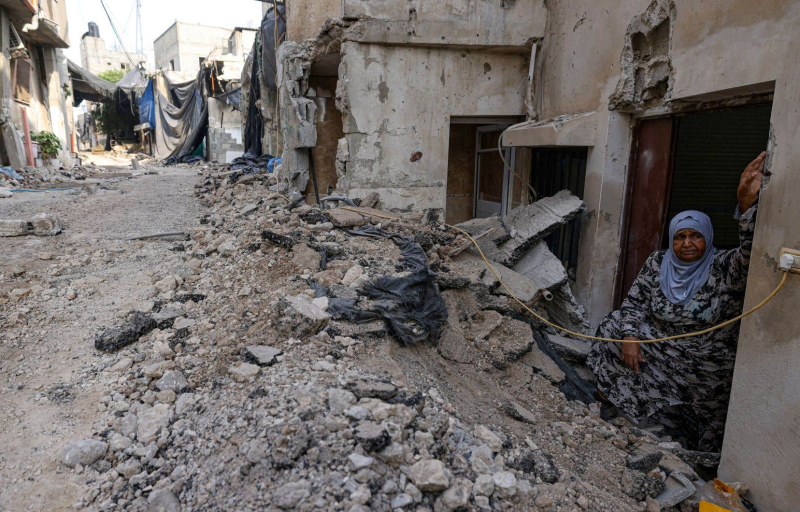
Photo: Jaafar Ashtiyeh Agence France-Presse The damage is significant in the Nur Shams refugee camp, near Tulkarem, in the occupied West Bank.
Magdaline Boutros
Published at 11:06 Updated at 17:09
- Middle East
“I hear the sound of bulldozers and their roar, the sound of drones and cars of the occupation army, and the sound, from time to time, of bullets and explosions.” Holed up in his home in the Jenin camp in the northern West Bank, Asri Mohammed Ahmed Fayadh has watched, for three days, destruction being sown at his doorstep. “I'm afraid to leave the house for fear of being hit by sniper bullets,” he told Le Devoir Thursday evening.
On the sidelines of the war in Gaza, the Israeli army launched a vast “anti-terrorist operation” on Wednesday in the West Bank, a Palestinian territory occupied by the Hebrew state since the Six-Day War in 1967.
Columns of armored vehicles and air raids were launched on the cities of Jenin, Tulkarem, Tubas and their refugee camps, where armed groups are active. At least 19 Palestinians were killed, including Hamas and Islamic Jihad fighters. The dead included “children,” according to the UN.
Special army units first infiltrated the Jenin camp, said Asri Mohammed Ahmed Fayadh, a 60-year-old journalist. “Then bulldozers rolled down the streets of the city and the camp, accompanied by the deployment of snipers in several high buildings overlooking the main streets. »
From the first moments of the incursion, bulldozers destroyed roads and houses. Electricity and drinking water supplies have been partially cut off. “The occupation's bulldozers are uprooting electricity networks and water pipes.”
Mr. Fayadh also reported that Israeli forces had taken control of the youth center and the women's center in the Jenin camp, turning them into a headquarters. “The hospitals are under siege. Every ambulance that comes in is subject to inspection,” he added. This information was corroborated to Agence France-Presse by Ahmed Zahran, a Red Crescent first-aid worker. “Medical teams have been hampered since the start of the assault,” he testified.
Read also
- At least 16 Palestinians killed in 48 hours in the occupied West Bank
- Large Israeli military operation in the occupied West Bank, eleven Palestinians killed
- ‘Humanitarian pauses’ to take place in Gaza for polio vaccinations
Withdrawals
Israeli incursions into Palestinian autonomous areas are a daily occurrence in the West Bank, but they are rarely on this scale. On Friday, Israel claimed to have killed Waseem Khazem, a Hamas leader in Jenin, in a drone strike as he was driving with two other militants. The day before, a local Islamic Jihad leader, Mohammed Jaber, better known as Abu Shujaa, was killed in a raid on the town of Tulkarem. Israel says it is carrying out this military operation to prevent deadly attacks against it.
In the last few hours, the Israeli army has withdrawn from the towns and camps of Tubas and Tulkarem. “What’s the difference between Gaza and us? ?” Nayef Alaajmeh, a resident of the Nour Shams camp in Tulkarem, lamented to AFP as he looked around at the destroyed buildings and impassable roads. “We are a second Gaza.”
Said Abou Malla, a journalist and professor at the Arab American University in Jenin, told Le Devoir that he expected the Israeli army to withdraw from Jenin soon as well. “After about fifty hours of raids, the army has nothing left to do,” he said. “The resistance groups in the West Bank are few in number, contrary to what the Israeli occupation claims.”
According to him, “they are scattered and unorganized elements, which have only light weapons.” “The Israelis exaggerate greatly to justify the killings, raids and destruction,” he adds.
“Excessive use” of force
Since Wednesday, the UN has been calling for an “immediate” cessation of the operation in the West Bank and reminding Israel of “its obligations under international humanitarian law and to take measures to protect civilians.”
In an interview with Devoir, Bill Van Esveld, deputy director in Israel and Palestine for Human Rights Watch, expressed concern about “the excessive use of violence” by Israel and the “lack of measures to protect civilians.” Under international law, the West Bank is not a war zone, but rather occupied territory, he points out. “The permissible use of force is that of a police officer,” and lethal force should therefore only be used if there is an immediate threat to the life of another.
On Friday, London said it was “deeply concerned by the methods used by Israel and by reports of civilian casualties and destruction of civilian infrastructure” in the West Bank, calling for an “urgent de-escalation.”
For France, these operations “worsen an unprecedented climate of instability and violence.” Spain, for its part, denounced “an outbreak of violence that is clearly unacceptable.”
Increase in violence
The military operation comes after a sharp increase in violence in the West Bank following Israel's response to Hamas attacks on October 7, 2023. According to the UN, at least 637 Palestinians have been killed in the West Bank by the Israeli army or settlers since that date. Israel, for its part, deplores the death of 19 of its citizens, including soldiers.
In the Gaza Strip, which has been pounded by the Israeli army for 10 months, the Hamas government's Health Ministry has reported at least 40,602 deaths. The Hamas attack on October 7 left 1,199 Israelis dead, and 251 people taken hostage.
With Agence France-Presse

